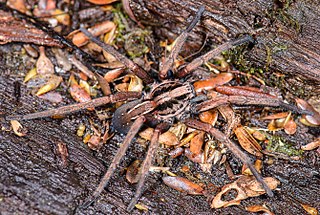
The family Dipluridae, known as curtain-web spiders are a group of spiders in the infraorder Mygalomorphae, that have two pairs of booklungs, and chelicerae (fangs) that move up and down in a stabbing motion. A number of genera, including that of the Sydney funnel-web spider (Atrax), used to be classified in this family but have now been moved to Hexathelidae.

Nursery web spiders (Pisauridae) is a family of araneomorph spiders first described by Eugène Simon in 1890. They resemble wolf spiders (Lycosidae) except for several key differences. Wolf spiders have two very prominent eyes in addition to the other six, while a nursery web spider's eyes are all about the same size. Additionally, female nursery web spiders carry their egg sacs with their jaws and pedipalps instead of attaching them to their spinnerets as wolf spiders do. When the eggs are about to hatch, a female spider builds a nursery "tent", places her egg sac inside, and stands guard outside, hence the family's common name. Like the wolf spiders, however, the nursery web spiders are roaming hunters that don't use webs for catching prey.

Miturgidae is a family of araneomorph spiders that includes nearly 170 species in 29 genera worldwide. First described by Eugène Simon in 1886, it has been substantially revised, including of previous family "Zoridae" as subfamily "Zorinae" and excluding the family "Xenoctenidae". Several genera have also been removed, such as the large genus Cheiracanthium, which was transferred to the Eutichuridae.

Hexathelidae is a family of mygalomorph spiders. It is one of a number of families and genera of spiders known as funnel-web spiders. In 2018, the family was substantially reduced in size by genera being moved to three separate families: Atracidae, Macrothelidae and Porrhothelidae. Atracidae includes the most venomous species formerly placed in Hexathelidae.

Barychelidae, also known as brushed trapdoor spiders, is a spider family with about 300 species in 42 genera. Most spiders in this family build trapdoor burrows. For example, the 20 millimetres (0.79 in) long Sipalolasma builds its burrow in rotted wood, with a hinged trapdoor at each end. The 10 millimetres (0.39 in) long Idioctis builds its burrow approximately 5 centimetres (2.0 in) deep, just below the high tide level, sealing the opening with a thin trapdoor.

Migidae, also known as tree trapdoor spiders, is a family of spiders with about 100 species in eleven genera. They are small to large spiders with little to no hair and build burrows with a trapdoor. Some species live in tree fern stems. They have a Gondwanan distribution, found almost exclusively on the Southern Hemisphere, occurring in South America, Africa, Madagascar, Australia, New Zealand and New Caledonia.
Masteria is a genus of curtain web spiders that was first described by L. Koch in 1873. They occur in the tropics of Central to South America, Asia and Micronesia, with one species found in Australia. M. petrunkevitchi males are 4 millimetres (0.16 in) long and females are 5 millimetres (0.20 in) long. M. lewisi, M. barona, and M. downeyi are slightly smaller and have only six eyes.
Caledothele elegans is a spider species in the genus Caledothele found in New Caledonia.
Barycheloides is a genus of South Pacific brushed trapdoor spiders first described by Robert Raven in 1994.
Encyocrypta is a genus of South Pacific brushed trapdoor spiders first described by Eugène Simon in 1889.
Idioctis is a genus of brushed trapdoor spiders that was first described by L. Koch in 1874.
Natgeogia is a monotypic genus of South Pacific brushed trapdoor spiders containing the single species, Natgeogia rastellata. It was first described by Robert Raven in 1994, and has only been found on New Caledonia.
Orstom is a genus of South Pacific brushed trapdoor spiders first described by Robert Raven in 1994.
Questocrypta is a monotypic genus of South Pacific brushed trapdoor spiders containing the single species, Questocrypta goloboffi. It was first described by Robert Raven in 1994, and has only been found on New Caledonia.
Stenygrocercus is a genus of South Pacific curtain web spiders that was first described by Eugène Simon in 1892.
Caledomedes is a genus of nursery web spiders containing the single species, Caledomedes flavovittatus. It was first described by Robert J. Raven & W. Hebron in 2018, and is only found in New Caledonia.
Ornodolomedes Marshi was named after an Ingham cane farmer in North Queensland, John Marsh.
Tasmomedes is a genus of nursery web spiders containing the single species, Tasmomedes eberhardarum. It was first described by Robert J. Raven & W. Hebron in 2018, and is only found in Australia.
Euagridae is a family of mygalomorph spiders. The group was first described as a tribe in 1979 by Robert Raven, who in 1985 elevated it to a subfamily. In 2020, Optova et al. elevated it further to a family.





